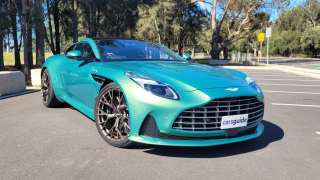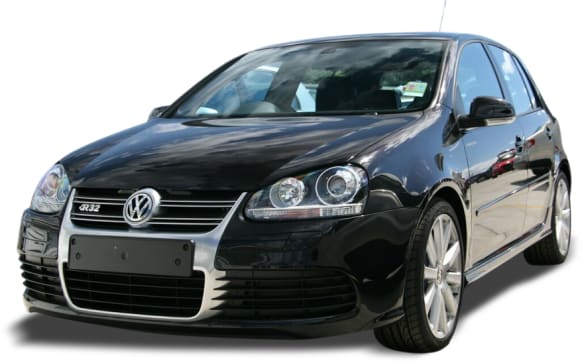
Volkswagen Golf GTI 2009 review
- Volkswagen Golf
- Volkswagen Golf 2009
- Volkswagen Golf Reviews
- Volkswagen Reviews
- Volkswagen Hatchback Range
- Hatchback
- Volkswagen
- European
- Small Cars
- Sports cars
- Hot hatches
And VW has taken that approach with the new version.
The GTI has long been the yardstick for the hot hatch class, and has a huge fan club. It´s sold 1.7 million around the world since it first appeared in 1976. In Australia, the Golf was VW´s best-selling model last year, and about 25 per cent of the 11,632 buyers were happy to pay the extra $13,000 whack to get into the GTI.
So the new car has been patterned after the old one in just about every way. Anything that has been changed in this sixth generation still follows the recipe, and a lot has been carried over.
The body is still in both three-door or five-door form, but now crouches 22mm lower at the front and 15mm at the rear, sitting on retuned springs, dampers and stabilisers, all aiming to increase the already agile handling..
There are subtle changes to the looks, mainly around the front. Where the previous model had a gaping grille and rounded light elements, the revamped version of the black honeycomb grille has a body-coloured strip dissecting it, and the red bezel accent is now parallel lines accentuating the more geometric foglights and chunkier lower air dam.
At the tail, the dual exhausts and revised diffuser have come from the concept shown at the recent Paris Motor Show, but apart from those details there is little altered around the back.
Slip into the driver’s seat and you’ll find the flat-bottomed steering wheel has been given a cosmetic brush-up with more red-stitched finish, the centre stack has been revamped a little, and there are touches of chrome on the instruments.
The car gets the a turbocharged 2.0-litre four cylinder TSI engine, with the same 280Nm of torque as the previous GTI but 8kW more power at 155kW due to a slightly modified induction system, and changes to pistons and pumps that make for less friction.
The maximum toque now has an earlier entry and even better spread from 1700-5200rpm (1800-5000 previously), but there is no gain over the 0-100km/h of 6.9 seconds (auto) and 7.2 seconds (manual) of the outgoing mode. However, the rolling acceleration from 80-120km/h is 7.5 seconds in fifth gear and 9.6 seconds in sixth – slower than figures clocked during independent tests of GTI MkV that had it at 6.9 and 8.6 respectively.
However it has picked up 5km for the top speed to come in at 240 km/h, and has cut fuel consumption from 8.2l/100km down to 7.5l/100. Emissions are similarly down from 197g/km of CO2 to 170g/km of CO2, helping it meet Euro 5 emissions compliance. .
Those hoping to see the seven-speed twin-clutch transmission that is trickling across the Volkswagen stables will be disappointed – the GTI is keeping the six-slot DSG for the moment, along with the six-speed manual – until the seven is developed to handle a better torque load.
However there are still some important – although not revolutionary — changes under the skin, including a new electronically controlled diff that loads up the inside wheel in cornering for better traction, handling and to reduce understeer. It’s not activated by slip, and not actually a diff lock as such, but more an application of judicious braking to bring the wheel under better control.
And just in case you exceed the limit of the diff’s ability, there’s now a seventh (knee) airbag.
The main feature (seen on a lot of stable-mate Audi’s cars) is an adaptive chassis control system with three modes – comfort, normal and sport – that can be selected to change the suspension and steering to suit the conditions. Sadly, it’s not standard but an option on other Golfs, and could end up being an expensive addition to the GTI.
Also available as an option is adaptive cruise control, which automatically brakes and accelerates between 30k-210 km/h, bi-xenon headlights, revised park assist that now guides you into any spot as small as 1.1metres longer than the car (1.4 previously).
There are no indications yet of whether the GTI will be hit with a huge price increase, and the decision is more likely to depend on currency exchange rates than any other factor.
However VW Australia spokesman Karl Gehling says efforts will be made to keep it close to the current model’s prices, which start at $38,990 for the three-door manual.
“We worked hard on the new Golf to maintain a competitive price point, and will do the same with GTI,” Gehling says.
“We want to keep it as close to the current pricing as possible, but we have to take into account the different specification for the new GTI, and of course there’s the effect of whatever happens with the Australian dollar.”
Gehling says that while he won’t make any sales predictions, VW could reasonably expect to hold the current figures of 200-250 per month
Driving
The GTI at once feels familiar, and yet you’re aware of the changes. For a start, the engine sounds rortier – but that could be extra noise defence padding the cabin.
Except for some wind-rush around the wing mirrors, the interior is now hush-quiet – all the better to hear the engine with, especially in Sport mode on the DSG where you get a delicious crackle and pop through the changes.
And that’s where you’ll probably want to keep it, if you opt for the twin-clutch. The normal fully auto mode is noticeably sluggish by comparison … although probably better designed for you to approach the official improved fuel figure.
But it will be tempting to ignore the fuel budget, because the engine is an enthusiastic partner in environmental crime, letting you dip into the torque quite early and happy to give up more right across the range.
Steering is precise and refined, perhaps too refined as there were complaints from some of the drivers at the launch in France about a lack of feedback. However VW says nothing has changed on the system from MkV GTI.
And the tendency of the comfort setting on the chassis control system to render the steering and dynamic abilities of a chocolate pudding — compared with the sport mode – didn’t endear it a great deal. In comfort mode with full auto on the DSG, the car felt too sluggish, and very uncharacteristic of a GTI.
Dialling up the sportiest notch on the chassis control system helped the dynamics a bit when you were in auto, but by far the best fun of course is with all that added to the DSG’s sport function.
It insists on holding the gears, changes down almost before you think you want to and offers slot-car manners around the corners.
The suspension in this setting was brilliant for cutting through some sharp cornering, but you could clearly feel the effect when the wheels hit uneven edges in some places.
The manual shift is smooth and solid — without being heavy — and deliciously precise, and is probably going to remain the favourite of those who want to really get to grips with their driving, despite VW saying the DSG shifts faster.
The electronic stability control is unobtrusive, and there was little sign of understeer – even when it was punched hard through the bends – which suggests that the faux diff control’s braking effect is a worthwhile system.
Of course, most of those performance and handling points are part of the recipe of the current model. But with the new – or slightly new – one, it’s all slightly improved.
Pricing guides
Range and Specs
| Vehicle | Specs | Price* | |
|---|---|---|---|
| 1.6 Edition | 1.6L, PULP, 5 SP MAN | $4,620 – 6,820 | 2009 Volkswagen Golf 2009 1.6 Edition Pricing and Specs |
| 1.9 TDI Edition | 1.9L, Diesel, 6 SP | $5,830 – 8,140 | 2009 Volkswagen Golf 2009 1.9 TDI Edition Pricing and Specs |
| 77 TDI Trendline | 1.6L, Diesel, 7 SP AUTO | $5,500 – 7,810 | 2009 Volkswagen Golf 2009 77 TDI Trendline Pricing and Specs |
| GT Sport TDI | 2.0L, Diesel, 6 SP MAN | $6,930 – 9,790 | 2009 Volkswagen Golf 2009 GT Sport TDI Pricing and Specs |
$3,490
Lowest price, based on 33 car listings in the last 6 months















